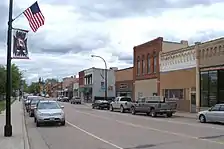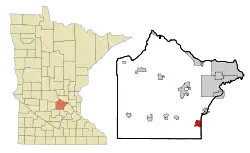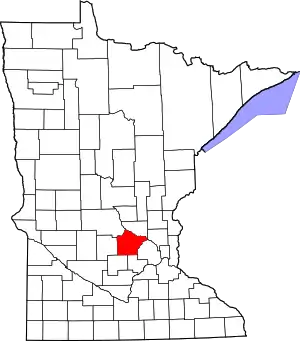Delano, Minnesota
Delano is a city in Wright County, Minnesota, United States. The population was 5,464 at the 2010 census.[6] It is part of the Twin Cities Metropolitan Statistical Area.
Delano | |
|---|---|
 | |
| Motto(s): The Spirit of Community | |
 Location of the city of Delano within Wright County, Minnesota | |
| Coordinates: 45°2′N 93°47′W | |
| Country | United States |
| State | Minnesota |
| County | Wright |
| Government | |
| • Type | Mayor–Council |
| • Mayor | Dale J. Graunke |
| Area | |
| • Total | 4.43 sq mi (11.47 km2) |
| • Land | 4.43 sq mi (11.47 km2) |
| • Water | 0.00 sq mi (0.00 km2) |
| Elevation | 922 ft (281 m) |
| Population | |
| • Total | 5,464 |
| • Estimate (2019)[3] | 6,302 |
| • Density | 1,423.22/sq mi (549.55/km2) |
| Time zone | UTC-6 (Central (CST)) |
| • Summer (DST) | UTC-5 (CDT) |
| ZIP code | 55328 |
| Area code(s) | 763 |
| FIPS code | 27-15454[4] |
| GNIS feature ID | 0642749[5] |
| Website | www.delano.mn.us |
History
Delano was platted in 1868, and named after Francis Roach Delano, a railroad official.[7] A post office has been in operation at Delano since 1870.[8] Delano was incorporated in 1876.[7] Three buildings in the town are on the National Register of Historic Places: the 1880s Eagle Newspaper Office, the 1888 Delano Village Hall, and the 1893 Simon Weldele House.[9]
Geography
According to the United States Census Bureau, the city has a total area of 4.05 square miles (10.49 km2), all land.[10] U.S. Highway 12 serves as a main route in the community. Other routes include County Roads 6 and 11 (from Minneapolis), 16, 17, and 30.
Delano is located at 45.04 degrees north, 93.78 degrees west, along the South Fork of the Crow River. The ZIP code is 55328.
Education
Delano is known for its strong public school system. In 2013, Forbes selected Delano over every other town in the United States as the "Best School for Your Housing buck." Delano schools produces exceptionally high test scores that complement its top-of-the-line athletic facilities. Delano also has parochial schools, which include St. Maximilian Kolbe Catholic School and Mt. Olive Lutheran School.
Demographics
| Historical population | |||
|---|---|---|---|
| Census | Pop. | %± | |
| 1880 | 407 | — | |
| 1890 | 889 | 118.4% | |
| 1900 | 967 | 8.8% | |
| 1910 | 1,031 | 6.6% | |
| 1920 | 924 | −10.4% | |
| 1930 | 914 | −1.1% | |
| 1940 | 1,094 | 19.7% | |
| 1950 | 1,386 | 26.7% | |
| 1960 | 1,612 | 16.3% | |
| 1970 | 1,851 | 14.8% | |
| 1980 | 2,480 | 34.0% | |
| 1990 | 2,709 | 9.2% | |
| 2000 | 3,836 | 41.6% | |
| 2010 | 5,464 | 42.4% | |
| 2019 (est.) | 6,302 | [3] | 15.3% |
| U.S. Decennial Census | |||
2015 and 2010 census
As of the census[2] of 2015, there were 5,875 people, 2,064 households, and 1,948 families living in the city. The population density was 1,349.1 inhabitants per square mile (520.9/km2). There were 2,064 housing units at an average density of 509.6 per square mile (196.8/km2). The racial makeup of the city was 96.0% White, 0.4% African American, 0.3% Native American, 1.0% Asian, 0.6% from other races, and 1.7% from two or more races. Hispanic or Latino of any race were 1.4% of the population.
There were 2,064 households, of which 31.9% had children under the age of 18 living with them, 58.9% were married couples living together, 9.1% had a female householder with no husband present, 4.3% had a male householder with no wife present, and 27.6% were non-families. 23.0% of all households were made up of individuals, and 9.8% had someone living alone who was 65 years of age or older. The average household size was 2.89 and the average family size was 3.29.
The median age in the city was 34.9 years. 31.9% of residents were under the age of 18; 6.2% were between the ages of 18 and 24; 27.3% were from 25 to 44; 24.7% were from 45 to 64; and 9.8% were 65 years of age or older. The gender makeup of the city was 48.8% male and 51.2% female.
2000 census
As of the census[4] of 2000, there were 3,836 people, 1,368 households, and 986 families living in the city. The population density was 1,492.8 people per square mile (576.4/km2). There were 1,391 housing units at an average density of 541.2 per square mile (209.0/km2). The racial makeup of the city was 98.18% White, 0.34% African American, 0.16% Native American, 0.29% Asian, 0.31% from other races, and 0.73% from two or more races. Hispanic or Latino of any race were 0.91% of the population.
There were 1,368 households, out of which 45.4% had children under the age of 18 living with them, 60.5% were married couples living together, 8.3% had a female householder with no husband present, and 27.9% were non-families. 22.9% of all households were made up of individuals, and 8.0% had someone living alone who was 65 years of age or older. The average household size was 2.80 and the average family size was 3.37.
In the city, the population was spread out, with 33.5% under the age of 18, 6.8% from 18 to 24, 35.4% from 25 to 44, 17.1% from 45 to 64, and 7.1% who were 65 years of age or older. The median age was 31 years. For every 100 females, there were 96.6 males. For every 100 females age 18 and over, there were 94.7 males.
The median income for a household in the city was $52,917, and the median income for a family was $63,011. Males had a median income of $40,902 versus $30,562 for females. The per capita income for the city was $21,538. About 1.1% of families and 2.7% of the population were below the poverty line, including 3.0% of those under age 18 and 8.8% of those age 65 or over.
Government
The city of Delano is organized by a mayor-council government. The current mayor is Dale Graunke. He was first elected in 2010, served a four-year term and was then re-elected in the 2014 election. The city councils that help govern Delano consists of five elected officials. Currently those officials are Betsy Stolfa, Jack Russek, Jason Franzen, and Holly Shrupp. Each council member serves a four-year term. Council Members Russek and Stolfa's terms expire in 2016, while Council Members Franzen and Shrupp's terms expire in 2018. Delano also has a park and recreation commission, planning commission, public safety commission, and water, light, and safety commission. Each of these commissions consists of seven members who are appointed by the city council and serve three-year terms.[11]
Culture
Delano is home to the oldest and largest Fourth of July celebration in Minnesota. The first known Fourth of July celebration was held July 4, 1857, near Fountain Lake. The celebration lasts at least four days, and includes various forms of entertainment and activities. The celebrations begin with local baseball and softball tournaments, the arrival of the carnival in Central Park, and the coronation of Delano Royalty. The Fourth of July parade begins at 10:30 am, and the evening closes with a fireworks display.
The films A Simple Plan and Grumpy Old Men were filmed in Delano.
Delano is home to the bimonthly Kurier Polski Newspaper, the sole Polish/American newspaper in the Midwest, with a distribution of 1500.
Notable person
- Tom Emmer – member of the Minnesota House of Representatives from 2005 to 2011, and the Republican nominee for Minnesota Governor in the 2010 election. On June 5, 2013, he announced he would seek the 6th Congressional District seat being vacated by Michele Bachmann. He was seated as the US Representative for the district in January 2015.
References
- "2019 U.S. Gazetteer Files". United States Census Bureau. Retrieved July 26, 2020.
- "American FactFinder". United States Census Bureau. Retrieved 2017-02-07.
- "Population and Housing Unit Estimates". United States Census Bureau. May 24, 2020. Retrieved May 27, 2020.
- "U.S. Census website". United States Census Bureau. Retrieved 2008-01-31.
- "US Board on Geographic Names". United States Geological Survey. 2007-10-25. Retrieved 2008-01-31.
- "2010 Census Redistricting Data (Public Law 94-171) Summary File". American FactFinder. U.S. Census Bureau, 2010 Census. Retrieved 23 April 2011.
- Upham, Warren (1920). Minnesota Geographic Names: Their Origin and Historic Significance. Minnesota Historical Society. p. 587.
- "Wright County". Jim Forte Postal History. Archived from the original on 22 November 2015. Retrieved 1 August 2015.
- "Minnesota National Register Properties Database". Minnesota Historical Society. 2009. Retrieved 2017-01-29.
- "US Gazetteer files 2010". United States Census Bureau. Archived from the original on 2012-01-25. Retrieved 2012-11-13.
- http://www.delano.mn.us/city-services
External links
| Wikimedia Commons has media related to Delano, Minnesota. |
